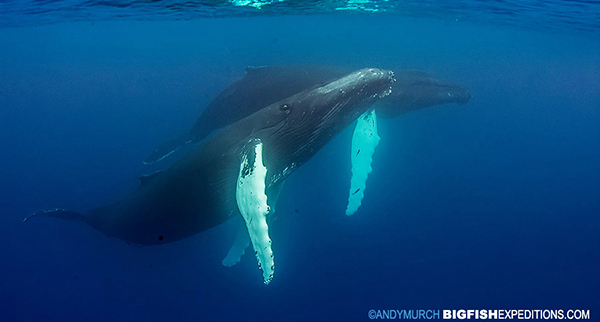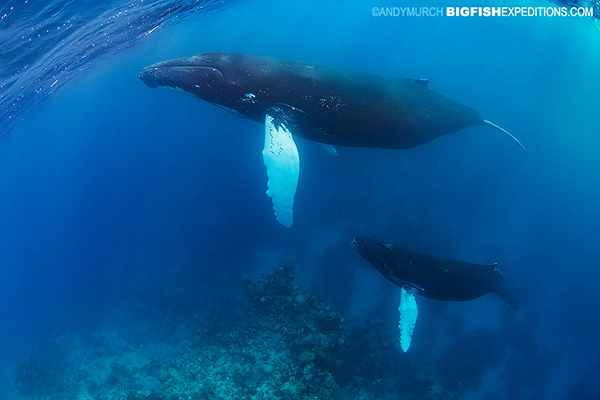The Humpback Whale
Author: Hannah O’Shea
Photos: Thank you to Andy Murch for the use of his photos
Common Name: Humpback Whale
Scientific Name: Megaptera novaeangliae
Size Range: The females range from 15-16 metres in length and the males range from 13-14 metres in length.
Status: Endangered (least concern)
Population: It is estimated that there are just over 10 000 – 15 000 whales.
Identifying Features: The Humpback Whale is mostly grey or black with a white underside. They have a distinctive hump in front of their small dorsal fin, which is toward the tail. A very noticeable characteristic is their long flippers. They are large creatures, ranging from 13-16 metres in length and weighing an average 36 000 kilograms. They contain anywhere from 14-35 throat groves that go from the chin to the navel. These grooves are for allowing their throats to expand during filter feeding when they intake huge amounts of water. They have small, round bumps (called tubercles) on the front of their head.
The Humpback Whales are famous for their “song”. In the winter breeding season, males make a long series of calls that may go on for several hours. The song is shared by any singing members in the area and as the song changes, all of the members change with it. They will sing this song together even when they are up to 5000 kilometres apart.
Habitat: Humpback Whales are very wide spread throughout the world. However they make seasonal migrations between low latitude winter grounds and high latitude summer grounds. The winters are for mating and calving in sub-tropical waters, followed by a migration back to cold waters to feed in summer. In the Northern Hemisphere they can be found in the north Pacific, from South-East Alaska, Prince WIlliam Sound and British Columbia; they migrate to Hawaii, Gulf of California, Mexico, and Costa Rica. Humpbacks from Western Aleutians and the Bering Sea migrate to Korea, Japan, Philippines, and northern Marianas. In the North-West Atlantic they can be found in areas around Iceland, southern Greenland, Norway, Svalbard, the eastern seaboard of Canada, and the United States; they migrate to the Caribbean, the southern Bahamas, the Grenadines, and Venezuela. Humpback Whales travel in pods from 2-15 members but these groups don’t last very long. They always come together to mate and feed. They are also known to be friendly to other marine life (they have been spotted socializing with other types of whales or dolphins). They tend to dive to about 200 metres, with each dive lasting about fifteen minutes before coming up for air. They are however known to be able to stay underwater for up to thirty minutes.
Food: Humpback Whales are baleen whales, meaning they contain plates of whale bone in their mouths. This acts as a filter that is used for straining plankton or krill from the water. Their diets consist of krill, anchovies, plankton, cod, sardines, and other small fish (including mackerel, capelin, herring, and sandeel). Humpback Whales have some interesting ways to capture their different types of food. They capture very small creatures by swimming through clouds of krill or plankton and suck in large amounts of water, then they push the water out through their baleens, which keeps the small creatures inside but not the water. They have an extremely strategic way of collecting larger fish. When Humpback Whales come together to feed, they are amazing pack hunters. They start by finding a school of fish and then some pod members will blow bubbles around the school, creating a cylinder the fish are trapped in. Other pod members will gather more fish into the cylinder. Another group of pod members will circle below and make sure no fish escape. Finally, the whales swim up through the middle of the cylinder and eat all of the fish.
Predators: Although Humpback Whales are very large, friendly creatures, they still have a couple predators. One predator they have is the Transient Killer Whales. They prey on marine animals and typically prey on calves and younger whales. There has not been a recorded attack, however on many whales, there are scars or drag marks as a result of an Orca attack. Location researchers predict that Humpback Whales breed in warm and tropical waters because Orcas rarely swim in that condition. The other predator Humpback Whales have, are sharks, but only the most aggressive shark species (Great White Sharks and Tiger Sharks). They often prey on calves but they will prey on adults that are sick or in distress. Many Humpback Whales have distinctive rake marks from Great White Shark teeth. Great Whites have been observed following these whales as they migrate. A defense they use is there massive tail. They use their tail to create a violent thump, which can frighten or injure the predator. They can also breach or charge at their predator.
Life Cycle: The lifespan of a Humpback Whale can range from 50-80 years. In some rare cases, they have been recorded to live much longer, for example, 100 years. Females become sexually mature at the age of five, and males become sexually mature at the age of seven. When it is time to mate, all of the males gather into groups near a female and fight for dominance. These fights consist of charging, breaching, floating with their heads above water (called “spy-hopping”), and slapping the water with their flukes to make loud sounds (called “lob-tailing”). The male that wins, gets to mate with the female. Mating happens during the winter in tropical waters. A Humpback Whale’s pregnancy lasts from 11-12 months. At birth, the calf weighs about 900 kilograms and it is 3-4.5 metres long. Females nurse theirs calves in shallow, warm waters.
Fun Facts!
- Megaptera novaeangliae is a latin name that translates to “the great winged newfoundlander” because of their huge wing-like flippers.
- Barnacles form on almost all Humpback Whales, which gives them a bearded appearance.
- When a Humpback Whale is spouting, it can be heard from up to 245 metres away and the spout can get as high as 6 metres tall.
- To prepare for a dive, Humpback Whales hump their back before going under, that is how they got their common name.
- Humpback Whales are massive creatures and their heart alone can reach almost 200 kilograms in weight. (That is equivalent to three full grown men!)
References:
Jeananda, C. (Updated 2018). Humpback Whale. enchantedlearning.com Retrieved January 3, 2020 from enchantedlearning.com/subjects/whales/species/Humpbackwhale.shtml
Mueller, J. (Updated 2020). What Preys on Humpback Whales? animals.mom.me Retrieved January 3, 2020 from animals.mom.me/preys-humpback-whales-3735.html
Oceanwide. (Updated 2020). Humpback Whale. Oceanwide-expditions.com Retrieved January 3, 2020 from oceanwide-expeditions.com/to-do/wildlife/humpback-whale
World Wildlife Fund. (Updated 2019). Humpback Whale. panda.org Retrieved January 3, 2020 from wwf.panda.org/our_work/wildlife/profiles/mammals/whales_dolphins/humpback_whale/






Leave a Reply
Want to join the discussion?Feel free to contribute!